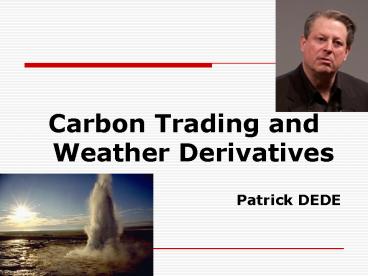Carbon Trading and Weather Derivatives PowerPoint PPT Presentation
1 / 19
Title: Carbon Trading and Weather Derivatives
1
- Carbon Trading and Weather Derivatives
- Patrick DEDE
2
Definition
- Emissions trading is an administrative approach
used to control pollution by providing economic
incentives for achieving reductions in the
emissions of pollutants. - Weather derivatives are financial instruments
that can be used by organizations or individuals
as part of a risk management strategy to reduce
risk associated with adverse or unexpected
weather conditions. The difference from other
derivatives is that the underlying asset
(rain/temperature/snow) has no direct value to
price the weather derivative.
3
Definition
- The Greenhouse Effect is the process by which
certain gases in the Earth's atmosphere to trap
heat from the surface. This effect creates an
insulating blanket around the earth that keeps
the planet warm.
4
The Kyoto Protocol
- The objective is to achieve "stabilization of
greenhouse gas concentrations in the atmosphere
at a certain level. - Requires EU, Canada, Japan (Annex 1 countries)
make mandatory cuts in emissions of carbon
dioxide and other gases. - By 2012 EU must reduce CO2 8 Canada 6 Japan
6 from 1990 levels. - Kyoto came into force on February 16, 2005 (90
days after Russia ratification). - Countries require large emitters to reduce GHG
emissions.
5
Market of Opportunity
- Six greenhouse gases emitted from industrial,
agricultural and consumer sources - methane (CH4),
- carbon dioxide (CO2),
- nitrous oxide (N2O),
- hydrofluorocarbons (HFCs),
- perfluorocarbons (PFCs), and
- sulphur hexafluoride (SF6)
- will be traded in the brokerage houses and
trading floors of the world markets.
6
Market of Opportunity
- EUR18 billion market for CO2
- Market opportunity has been estimated at EUR3
trillion over 20 year horizon and may be EUR100
billion by 2010 - Six European exchanges are about to trade carbon
emission and weather derivatives - One US exchange Chicago Climate Exchange
7
Market of Opportunity
- UBS is trying to change weather investing by
launching the first Global Warming Index (GWI),
which provides a simple way to take a view on a
wide range of weather variables. - Weather derivatives traded on the Chicago
Mercantile Exchange jumped from 9.7bn in 2004-5
to more than 45bn in 2005-6.
8
Energy Emission market
- The polluters in the Kyoto Protocol are
individual countries that have agreed to a
specific reduction target which are currently set
at an average of 5.2 per cent below 1990 levels
of emissions.
9
Energy Emission market
- In most respects, emissions markets are no
different from current financial markets. - They are subject to the same pressures of
capital markets, such as price volatility, boom
and bust cycles, speculative bubbles...
10
Market Mechanism
- Its a market-based solution to environmental
problems which refers specifically to air
pollution. - Each polluters are assigned targets for reducing
their emissions of gases in a pre-defined time
period.
11
Market Mechanism
- The polluters are then given a number of
emissions credits for the amount they are
allowed to pollute, which is the level of their
emissions minus their agreed target.
12
Market Mechanism
- There are several things that can happen
- Scenario 1
- The polluter uses up the whole allowance in the
allocated time period, but still pollute more. In
order to do remain in compliance, spare credits
must be bought from another polluter which has
not used up the whole allotment.
13
Market Mechanism
- Scenario 2
- The polluter does not use the whole allowance
and can either save the remaining credits for the
next time period (bank them), or sell the credits
to another polluter on the open market.
14
Market Mechanism
- Scenario 3
- The polluter can invest in numerous pollution
reduction schemes in other countries or regions
and earn credits from these projects which can
then be sold, banked or used to make up
shortfalls in the original allowance.
15
The Players
- Brokers and traders
- Oil and gas companies
- Electricity companies
- Industrials
- Agricultural producers
- Insurance and reinsurance providers
- Financial institutions
- Governments
- Hedge funds venture capital funds
16
Carbon risk management for companies
- The most important risk categories for companies
resulting from emission reduction targets are - Cash flow risks, such as increased expenditure on
measures aimed at reducing CO2 or the purchase of
emission allowances - Market perception risks which may influence
market capitalisation and - Capital cost risks, such as more stringent credit
conditions as a result of altered credit risk
ratings. The drawing up of emission inventories
and measures taken to increase energy efficiency
will, in future, play important roles in the
financial rating process. - To understand their potential carbon risks,
companies should have - in place a robust and accurate GHG inventory
which details past, - current, and projected future emissions.
17
HEDGING AGAINST CARBON RISK MANAGEMENT
- Financial services providers can assist
companies in managing these effects, and in
particular, reducing the transaction costs of
trading by offering new products and services. - The complexity of emissions trading requires a
wide range of products and services that
effectively hedge against risks emerging from the
Kyoto Protocol and the European trading scheme.
18
HEDGING AGAINST CARBON RISK MANAGEMENT
- Various types of derivatives can be used, such
as - Forwards the purchase of emission allowances to
be supplied in the future at a fixed price. - Options a guarantee of the right to purchase or
sell allowances at a fixed price within a defined
period of time and - Swaps the exchange of payment obligations so
that different allowance currencies can be
exchanged.
19
Conclusion
- Do not underestimate a few degrees change
because just 8 degrees Celsius separates
today's average temperatures from that of the
last ice age - Steven Chu, Physics Nobel Prize winner

